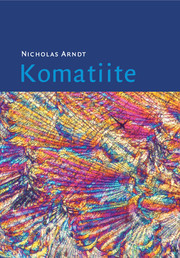Book contents
- Frontmatter
- Contents
- Preface
- Part I Background information – description of the field characteristics, mineralogy and geochemistry of komatiites
- Part II Interpretation – the manner of emplacement, the origin and the tectonic setting of komatiites
- 8 Physical properties of komatiites
- 9 Physical volcanology (by S. J. Barnes and C. M. Lesher)
- 10 Komatiite-associated Ni–Cu–PGE deposits (by C. M. Lesher and S. J. Barnes)
- 11 The hydrous komatiite hypothesis
- 12 Compositions and eruption temperatures of komatiitic liquids
- 13 Petrogenesis of komatiite
- 14 Geodynamic setting
- References
- General index
- Localities
- Plate section
11 - The hydrous komatiite hypothesis
from Part II - Interpretation – the manner of emplacement, the origin and the tectonic setting of komatiites
Published online by Cambridge University Press: 27 August 2009
- Frontmatter
- Contents
- Preface
- Part I Background information – description of the field characteristics, mineralogy and geochemistry of komatiites
- Part II Interpretation – the manner of emplacement, the origin and the tectonic setting of komatiites
- 8 Physical properties of komatiites
- 9 Physical volcanology (by S. J. Barnes and C. M. Lesher)
- 10 Komatiite-associated Ni–Cu–PGE deposits (by C. M. Lesher and S. J. Barnes)
- 11 The hydrous komatiite hypothesis
- 12 Compositions and eruption temperatures of komatiitic liquids
- 13 Petrogenesis of komatiite
- 14 Geodynamic setting
- References
- General index
- Localities
- Plate section
Summary
Introduction
Over the past decade Tim Grove and coworkers Maarten de Wit, Steve Parman and Jesse Dann have published a series of papers (de Wit and Stern, 1980; de Wit et al., 1983, 1987; Grove et al., 1994, 1996; Parman et al., 1996; Grove et al., 1997; Parman et al., 1997; Grove et al., 1999; Parman et al., 2001, 2003; Grove and Parman, 2004; Parman et al., 2004) in which they develop a model for the nature and origin of komatiite that is very different from the majority view. Most geologists and geochemists who have worked with komatiites appear to accept that these ultramafic magmas formed in unusually hot mantle plumes (Chapter 13) but Grove and coinvestigators have proposed instead that komatiites are hydrous magmas that formed at temperatures not much higher than those in ambient upper mantle. In their early papers they suggested that the volatiles in the source might have come from undegassed primordial mantle, but in later papers they advocated dehydration of oceanic crust in an Archean subduction zone. An important element of their hypothesis, at least as presented in the earlier papers, is the hypothesis that the komatiites of the Barberton belt are intrusive. According to their model, hydrous ultramafic magma did not erupt at the surface but intruded as dykes or sills into the upper parts of the basaltic volcanic pile.
- Type
- Chapter
- Information
- Komatiite , pp. 328 - 351Publisher: Cambridge University PressPrint publication year: 2008



